再生与不可再生能源(英文)
- 格式:ppt
- 大小:988.50 KB
- 文档页数:57
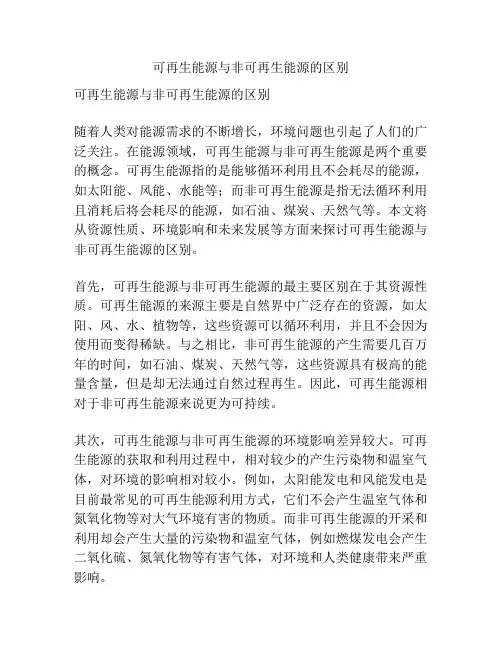
可再生能源与非可再生能源的区别可再生能源与非可再生能源的区别随着人类对能源需求的不断增长,环境问题也引起了人们的广泛关注。
在能源领域,可再生能源与非可再生能源是两个重要的概念。
可再生能源指的是能够循环利用且不会耗尽的能源,如太阳能、风能、水能等;而非可再生能源是指无法循环利用且消耗后将会耗尽的能源,如石油、煤炭、天然气等。
本文将从资源性质、环境影响和未来发展等方面来探讨可再生能源与非可再生能源的区别。
首先,可再生能源与非可再生能源的最主要区别在于其资源性质。
可再生能源的来源主要是自然界中广泛存在的资源,如太阳、风、水、植物等,这些资源可以循环利用,并且不会因为使用而变得稀缺。
与之相比,非可再生能源的产生需要几百万年的时间,如石油、煤炭、天然气等,这些资源具有极高的能量含量,但是却无法通过自然过程再生。
因此,可再生能源相对于非可再生能源来说更为可持续。
其次,可再生能源与非可再生能源的环境影响差异较大。
可再生能源的获取和利用过程中,相对较少的产生污染物和温室气体,对环境的影响相对较小。
例如,太阳能发电和风能发电是目前最常见的可再生能源利用方式,它们不会产生温室气体和氮氧化物等对大气环境有害的物质。
而非可再生能源的开采和利用却会产生大量的污染物和温室气体,例如燃煤发电会产生二氧化硫、氮氧化物等有害气体,对环境和人类健康带来严重影响。
此外,可再生能源与非可再生能源在未来的发展趋势也存在明显差异。
由于可再生能源具有可持续性和环保性等优势,国际社会对其发展越来越重视。
尤其是近年来,各国纷纷制定可再生能源发展规划,并投入大量资金用于研发和推广可再生能源技术。
相比之下,非可再生能源的使用正逐渐受到限制,因为其产量越来越少,对环境影响越来越大,人们对其依赖性也越来越低。
因此,未来的趋势是可再生能源将逐渐取代非可再生能源,成为人类主要的能源来源。
综上所述,可再生能源与非可再生能源在资源性质、环境影响和未来发展等方面存在着明显差异。
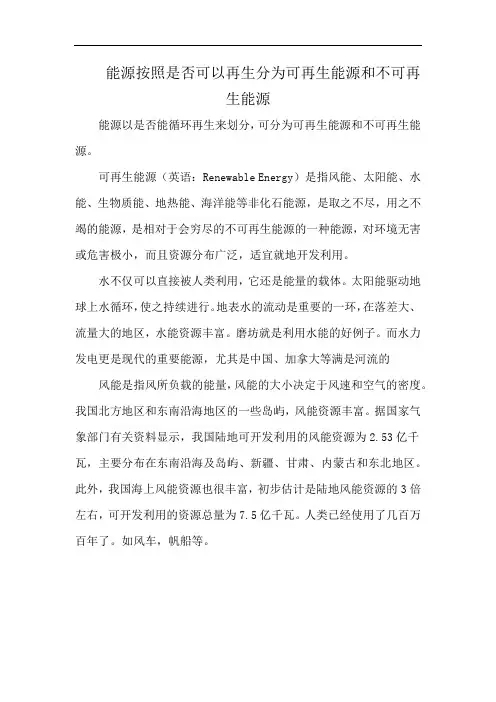
能源按照是否可以再生分为可再生能源和不可再
生能源
能源以是否能循环再生来划分,可分为可再生能源和不可再生能源。
可再生能源(英语:Renewable Energy)是指风能、太阳能、水能、生物质能、地热能、海洋能等非化石能源,是取之不尽,用之不竭的能源,是相对于会穷尽的不可再生能源的一种能源,对环境无害或危害极小,而且资源分布广泛,适宜就地开发利用。
水不仅可以直接被人类利用,它还是能量的载体。
太阳能驱动地球上水循环,使之持续进行。
地表水的流动是重要的一环,在落差大、流量大的地区,水能资源丰富。
磨坊就是利用水能的好例子。
而水力发电更是现代的重要能源,尤其是中国、加拿大等满是河流的风能是指风所负载的能量,风能的大小决定于风速和空气的密度。
我国北方地区和东南沿海地区的一些岛屿,风能资源丰富。
据国家气象部门有关资料显示,我国陆地可开发利用的风能资源为2.53亿千瓦,主要分布在东南沿海及岛屿、新疆、甘肃、内蒙古和东北地区。
此外,我国海上风能资源也很丰富,初步估计是陆地风能资源的3倍左右,可开发利用的资源总量为7.5亿千瓦。
人类已经使用了几百万百年了。
如风车,帆船等。
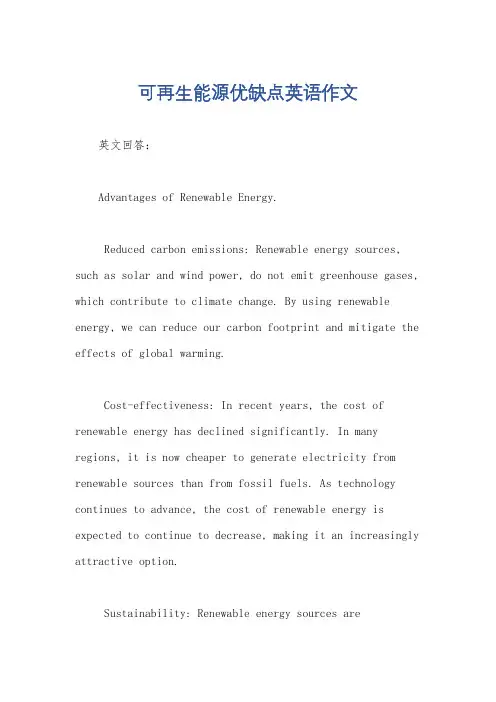
可再生能源优缺点英语作文英文回答:Advantages of Renewable Energy.Reduced carbon emissions: Renewable energy sources, such as solar and wind power, do not emit greenhouse gases, which contribute to climate change. By using renewable energy, we can reduce our carbon footprint and mitigate the effects of global warming.Cost-effectiveness: In recent years, the cost of renewable energy has declined significantly. In many regions, it is now cheaper to generate electricity from renewable sources than from fossil fuels. As technology continues to advance, the cost of renewable energy is expected to continue to decrease, making it an increasingly attractive option.Sustainability: Renewable energy sources arereplenished naturally, meaning that they can be used indefinitely without depleting the earth's resources. This is in contrast to fossil fuels, which are finite and non-renewable.Job creation: The renewable energy industry is growing rapidly, creating new jobs in manufacturing, installation, and maintenance. These jobs can provide economic benefits for local communities and help to reduce unemployment.Energy independence: By using renewable energy, we can reduce our reliance on foreign energy imports. This can help to improve our national security and reduce our vulnerability to energy price fluctuations.Disadvantages of Renewable Energy.Intermittency: Renewable energy sources, such as solar and wind power, are intermittent, meaning that they are not always available when we need them. This can be a challenge for grid operators, who need to ensure a reliable supply of electricity.Land use: Large-scale renewable energy projects, such as solar farms and wind farms, require a significant amount of land. This can be a concern in areas where land is scarce or expensive.Environmental impacts: While renewable energy is generally considered to be more environmentally friendly than fossil fuels, it can still have some negative environmental impacts. For example, wind turbines can kill birds, and solar panels can produce hazardous waste.Cost: Renewable energy projects can be expensive to build and maintain. This can be a barrier to entry for some businesses and communities.Government support: In many cases, renewable energy projects rely on government subsidies to be financially viable. This can lead to concerns about the long-term sustainability of renewable energy development.中文回答:可再生能源的优点。
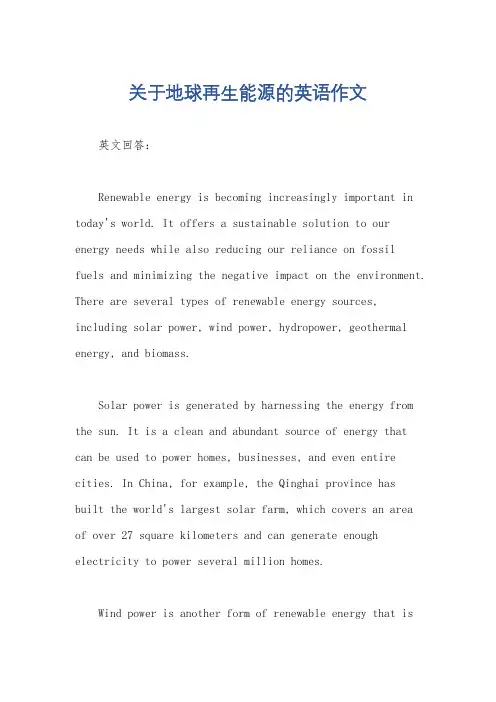
关于地球再生能源的英语作文英文回答:Renewable energy is becoming increasingly important in today's world. It offers a sustainable solution to our energy needs while also reducing our reliance on fossilfuels and minimizing the negative impact on the environment. There are several types of renewable energy sources, including solar power, wind power, hydropower, geothermal energy, and biomass.Solar power is generated by harnessing the energy from the sun. It is a clean and abundant source of energy that can be used to power homes, businesses, and even entire cities. In China, for example, the Qinghai province hasbuilt the world's largest solar farm, which covers an areaof over 27 square kilometers and can generate enough electricity to power several million homes.Wind power is another form of renewable energy that isgaining popularity. Wind turbines convert the kinetic energy of the wind into electricity. Countries like Germany and Denmark have made significant investments in wind energy and have become leaders in this field. In fact, Denmark is able to generate more than 40% of itselectricity from wind power.Hydropower, or the generation of electricity from flowing water, is also a major source of renewable energy. It is a reliable and cost-effective solution that has been used for centuries. The Three Gorges Dam in China is the largest hydropower station in the world, and it has the capacity to generate over 22,500 megawatts of electricity.Geothermal energy utilizes the heat from the Earth's core to generate electricity. This form of renewable energy is particularly abundant in areas with active volcanoes or geothermal hotspots. Iceland, for example, relies heavily on geothermal energy and is able to produce more than 25% of its electricity from this source.Biomass refers to organic matter, such as plants andanimal waste, that can be converted into energy. It is a versatile source of renewable energy that can be used for heating, electricity generation, and even transportation.In Sweden, for instance, biomass accounts for about 30% of the country's total energy consumption.In conclusion, renewable energy is crucial for a sustainable future. It provides us with a clean and abundant source of energy while also reducing our carbon footprint. By investing in renewable energy sources like solar power, wind power, hydropower, geothermal energy, and biomass, we can create a more sustainable and environmentally friendly world for future generations.中文回答:再生能源在当今世界变得越来越重要。
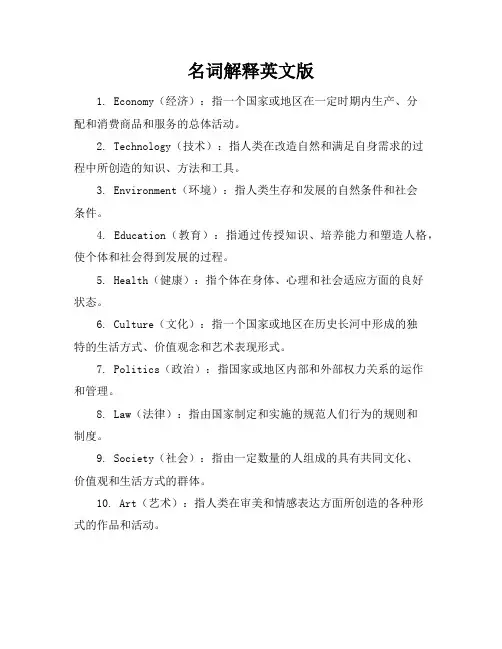
名词解释英文版1. Economy(经济):指一个国家或地区在一定时期内生产、分配和消费商品和服务的总体活动。
2. Technology(技术):指人类在改造自然和满足自身需求的过程中所创造的知识、方法和工具。
3. Environment(环境):指人类生存和发展的自然条件和社会条件。
4. Education(教育):指通过传授知识、培养能力和塑造人格,使个体和社会得到发展的过程。
5. Health(健康):指个体在身体、心理和社会适应方面的良好状态。
6. Culture(文化):指一个国家或地区在历史长河中形成的独特的生活方式、价值观念和艺术表现形式。
7. Politics(政治):指国家或地区内部和外部权力关系的运作和管理。
8. Law(法律):指由国家制定和实施的规范人们行为的规则和制度。
9. Society(社会):指由一定数量的人组成的具有共同文化、价值观和生活方式的群体。
10. Art(艺术):指人类在审美和情感表达方面所创造的各种形式的作品和活动。
重要工具。
通过学习这些名词的英文解释,我们可以更好地理解和参与国际交流与合作。
名词解释英文版11. Innovation(创新):指在现有知识和技能的基础上,创造出新的产品、服务、方法或理念,以满足人类需求或解决问题。
12. Sustainability(可持续性):指在满足当前世代需求的同时,不损害后代满足其需求的能力。
13. Diversity(多样性):指在一个群体、组织或社会中,存在不同的观点、背景、文化、性别、年龄等特征。
14. Inequality(不平等):指在资源、机会、权力或社会地位方面存在差异,导致某些人或群体处于不利地位。
15. Human rights(人权):指人类在生存、发展、自由和尊严方面享有的基本权利,这些权利应受到国家和社会的保护。
16. Democracy(民主):指一种政治制度,其中人民通过选举、投票等方式参与决策,政府权力来源于人民。
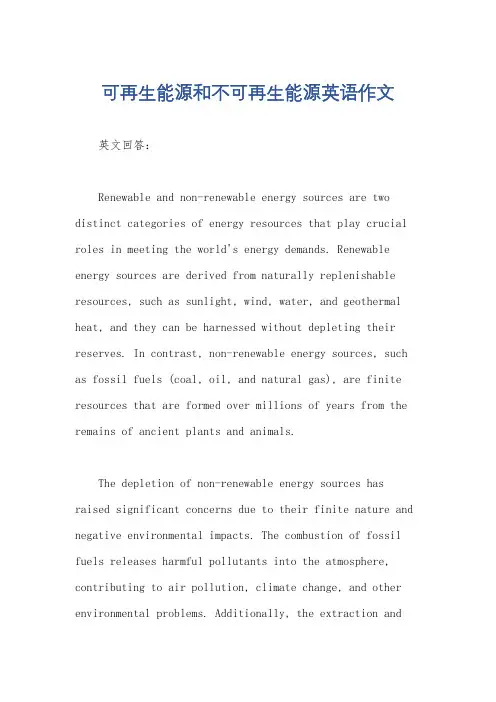
可再生能源和不可再生能源英语作文英文回答:Renewable and non-renewable energy sources are two distinct categories of energy resources that play crucial roles in meeting the world's energy demands. Renewable energy sources are derived from naturally replenishable resources, such as sunlight, wind, water, and geothermal heat, and they can be harnessed without depleting their reserves. In contrast, non-renewable energy sources, such as fossil fuels (coal, oil, and natural gas), are finite resources that are formed over millions of years from the remains of ancient plants and animals.The depletion of non-renewable energy sources has raised significant concerns due to their finite nature and negative environmental impacts. The combustion of fossil fuels releases harmful pollutants into the atmosphere, contributing to air pollution, climate change, and other environmental problems. Additionally, the extraction andproduction of fossil fuels can lead to land degradation, water pollution, and other environmental damage.In contrast, renewable energy sources offer numerous benefits that make them increasingly attractive as sustainable alternatives. These sources are environmentally friendly, producing minimal or zero emissions, thus mitigating air pollution and climate change. Renewable energy is also domestically available in many regions, reducing dependence on foreign energy imports and fostering energy independence. Furthermore, renewable energy technologies are becoming increasingly cost-competitive with traditional fossil fuels, making them economically viable options.Despite the advantages of renewable energy, there are challenges associated with their integration into existing energy systems. Intermittency, the variability in the availability of some renewable sources such as solar and wind, poses challenges to grid stability and requires careful planning and integration with other energy sources. Additionally, the cost of renewable energy technologies canbe higher than that of fossil fuels, although costs have been declining in recent years.To overcome these challenges and accelerate thetransition towards a sustainable energy future, governments, industries, and researchers are actively pursuing advancements in renewable energy technologies and policies. These efforts include investment in research and development, incentives for renewable energy adoption, and the establishment of supportive regulatory frameworks.In conclusion, renewable and non-renewable energy sources represent contrasting approaches to meeting the world's energy needs. While non-renewable energy sources have historically dominated the energy landscape, concerns over their depletion and environmental impacts have prompted a shift towards renewable energy sources. The benefits of renewable energy, including environmental friendliness, reduced emissions, energy independence, and cost-competitiveness, make them increasingly attractive as sustainable alternatives. However, challenges associatedwith intermittency and cost need to be addressed throughtechnological advancements and supportive policies to fully realize the potential of renewable energy in shaping a sustainable energy future.中文回答:可再生能源和不可再生能源。
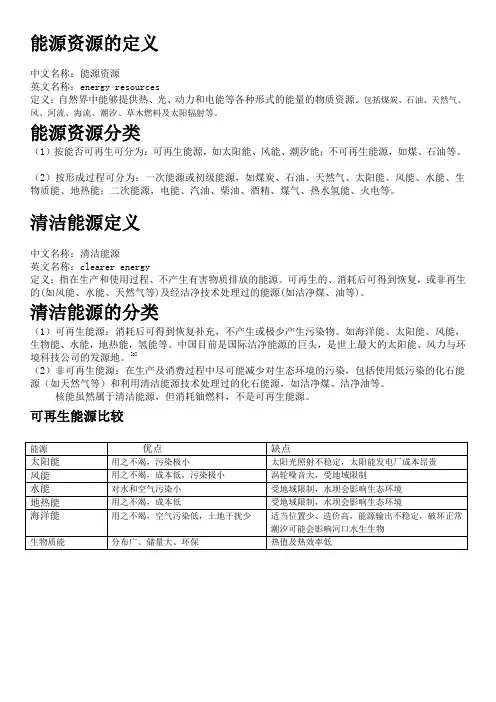
能源资源的定义中文名称:能源资源英文名称:energy resources定义:自然界中能够提供热、光、动力和电能等各种形式的能量的物质资源。
包括煤炭、石油、天然气、风、河流、海流、潮汐、草木燃料及太阳辐射等。
能源资源分类(1)按能否可再生可分为:可再生能源,如太阳能、风能、潮汐能;不可再生能源,如煤、石油等。
(2)按形成过程可分为:一次能源或初级能源,如煤炭、石油、天然气、太阳能、风能、水能、生物质能、地热能;二次能源,电能、汽油、柴油、酒精、煤气、热水氢能、火电等。
清洁能源定义中文名称:清洁能源英文名称:clearer energy定义:指在生产和使用过程、不产生有害物质排放的能源。
可再生的、消耗后可得到恢复,或非再生的(如风能、水能、天然气等)及经洁净技术处理过的能源(如洁净煤、油等)。
清洁能源的分类(1)可再生能源:消耗后可得到恢复补充,不产生或极少产生污染物。
如海洋能、太阳能、风能,生物能、水能,地热能,氢能等。
中国目前是国际洁净能源的巨头,是世上最大的太阳能、风力与环境科技公司的发源地。
[3](2)非可再生能源:在生产及消费过程中尽可能减少对生态环境的污染,包括使用低污染的化石能源(如天然气等)和利用清洁能源技术处理过的化石能源,如洁净煤、洁净油等。
核能虽然属于清洁能源,但消耗铀燃料,不是可再生能源。
可再生能源比较生产清洁能源的上市公司太阳能股票、太阳能上市公司:风能上市公司、风能股票:核能上市公司、核能股票:乙醇汽油:丰原生化(000930)是安徽省唯一一家燃料乙醇供应单位华润生化(600893)控股股东华润集团控股吉林燃料乙醇和黑龙江华润酒精二大定点企业广东甘化(000576)利用甘蔗、玉米等可再生性糖料资源生产燃油精,成为汽油代替品华资实业(600191)利用可再生性糖料资源生产燃油精,成为纯车用汽油代替品:荣华实业(600311)赖氨酸(豆粕的替代品)新增产能最大的企业之一万向德农(600371)在国内率先拥有了玉米深加工多项最新技术的所有权或使用权氢能:同济科技(600846)公司与中科院上海有机化学研究所、上海神力科技合资组建中科同力化工材料有限公司开发燃料电池电动车。
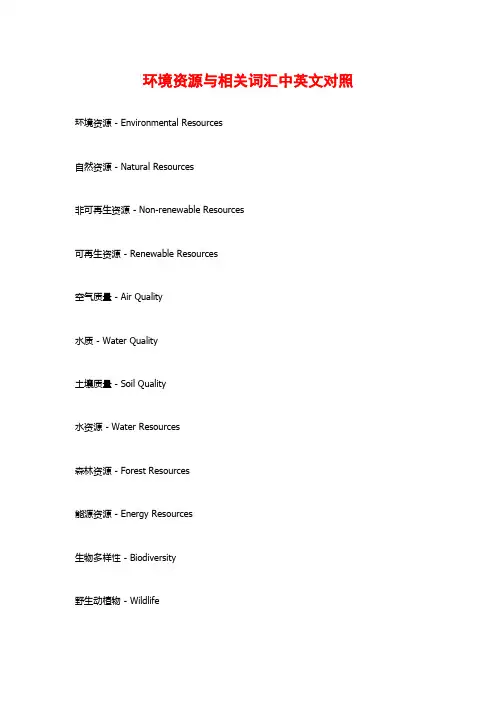
环境资源与相关词汇中英文对照环境资源 - Environmental Resources自然资源 - Natural Resources非可再生资源 - Non-renewable Resources可再生资源 - Renewable Resources空气质量 - Air Quality水质 - Water Quality土壤质量 - Soil Quality水资源 - Water Resources森林资源 - Forest Resources能源资源 - Energy Resources生物多样性 - Biodiversity野生动植物 - Wildlife可持续发展 - Sustainable Development污染 - Pollution气候变化 - Climate Change全球变暖 - Global Warming碳排放 - Carbon Emissions可回收物 - Recyclables废弃物 - Waste环境保护 - Environmental Conservation生态系统 - Ecosystem生态平衡 - Ecological Balance环境影响评估 - Environmental Impact Assessment 环境政策 - Environmental Policy可持续资源利用 - Sustainable Resource Utilization 环境可持续性 - Environmental Sustainability可持续消费 - Sustainable Consumption绿色技术 - Green Technology再生能源 - Renewable Energy节能减排 - Energy Conservation and Emission Reduction 生态恢复 - Ecological Restoration生物学多样性 - Biological Diversity环保意识 - Environmental Awareness环保教育 - Environmental Education。
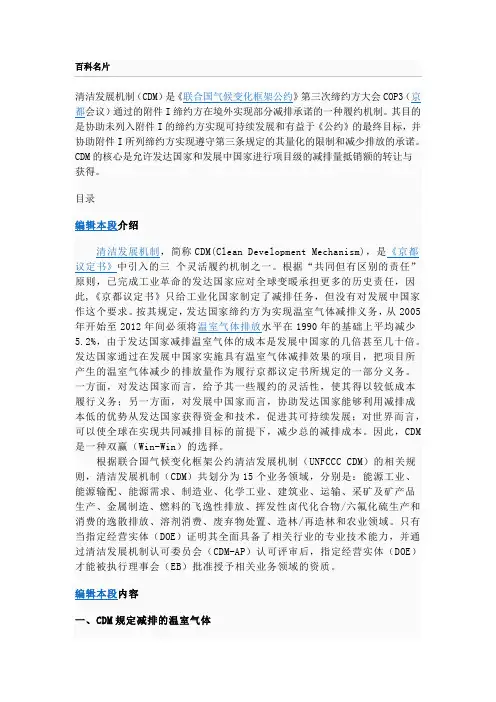
百科名片清洁发展机制(CDM)是《联合国气候变化框架公约》第三次缔约方大会COP3(京都会议)通过的附件I缔约方在境外实现部分减排承诺的一种履约机制。
其目的是协助未列入附件I的缔约方实现可持续发展和有益于《公约》的最终目标,并协助附件I所列缔约方实现遵守第三条规定的其量化的限制和减少排放的承诺。
CDM的核心是允许发达国家和发展中国家进行项目级的减排量抵销额的转让与获得。
目录编辑本段介绍清洁发展机制,简称CDM(Clean Development Mechanism),是《京都议定书》中引入的三个灵活履约机制之一。
根据“共同但有区别的责任”原则,已完成工业革命的发达国家应对全球变暖承担更多的历史责任,因此,《京都议定书》只给工业化国家制定了减排任务,但没有对发展中国家作这个要求。
按其规定,发达国家缔约方为实现温室气体减排义务,从2005年开始至2012年间必须将温室气体排放水平在1990年的基础上平均减少5.2%,由于发达国家减排温室气体的成本是发展中国家的几倍甚至几十倍。
发达国家通过在发展中国家实施具有温室气体减排效果的项目,把项目所产生的温室气体减少的排放量作为履行京都议定书所规定的一部分义务。
一方面,对发达国家而言,给予其一些履约的灵活性,使其得以较低成本履行义务;另一方面,对发展中国家而言,协助发达国家能够利用减排成本低的优势从发达国家获得资金和技术,促进其可持续发展;对世界而言,可以使全球在实现共同减排目标的前提下,减少总的减排成本。
因此,CDM 是一种双赢(Win-Win)的选择。
根据联合国气候变化框架公约清洁发展机制(UNFCCC CDM)的相关规则,清洁发展机制(CDM)共划分为15个业务领域,分别是:能源工业、能源输配、能源需求、制造业、化学工业、建筑业、运输、采矿及矿产品生产、金属制造、燃料的飞逸性排放、挥发性卤代化合物/六氟化硫生产和消费的逸散排放、溶剂消费、废弃物处置、造林/再造林和农业领域。
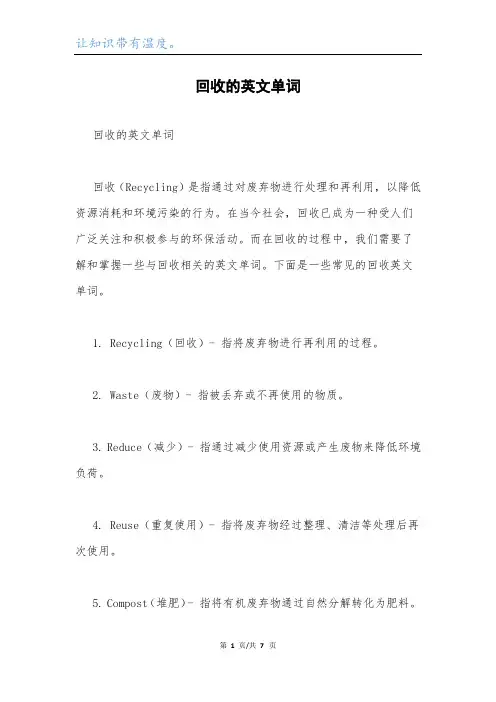
回收的英文单词回收的英文单词回收(Recycling)是指通过对废弃物进行处理和再利用,以降低资源消耗和环境污染的行为。
在当今社会,回收已成为一种受人们广泛关注和积极参与的环保活动。
而在回收的过程中,我们需要了解和掌握一些与回收相关的英文单词。
下面是一些常见的回收英文单词。
1. Recycling(回收)- 指将废弃物进行再利用的过程。
2. Waste(废物)- 指被丢弃或不再使用的物质。
3. Reduce(减少)- 指通过减少使用资源或产生废物来降低环境负荷。
4. Reuse(重复使用)- 指将废弃物经过整理、清洁等处理后再次使用。
5. Compost(堆肥)- 指将有机废弃物通过自然分解转化为肥料。
6. Recyclable(可回收的)- 指能够通过回收再利用的废弃物,如纸张、塑料瓶等。
7. Container(容器)- 指储存废弃物的装置,如垃圾桶、回收箱等。
8. Sorting(分类)- 指将不同类型的废弃物分别放置在不同的容器中。
9. Landfill(垃圾填埋场)- 指进行垃圾填埋和处理的地方。
10. Renewable(可再生的)- 指能够自然循环或通过人工手段再生的资源。
11. Pollution(污染)- 指对环境造成负面影响的废弃物或有害物质。
12. Sustainability(可持续性)- 指保持环境、经济和社会的可持续发展。
13. Landfill gas(填埋气体)- 指在垃圾填埋场中产生的气体,如甲烷等。
14. Renewable energy(可再生能源)- 指通过自然循环或人工手段不断产生的能源,如太阳能、风能等。
15. Biodegradable(可生物降解的)- 指能够经过自然分解而变为无害物质的废弃物。
16. E-waste(电子废物)- 指丢弃的电子设备、电池等废弃物。
17. Hazardous waste(危险废物)- 指对人类和环境有潜在危害的废弃物。
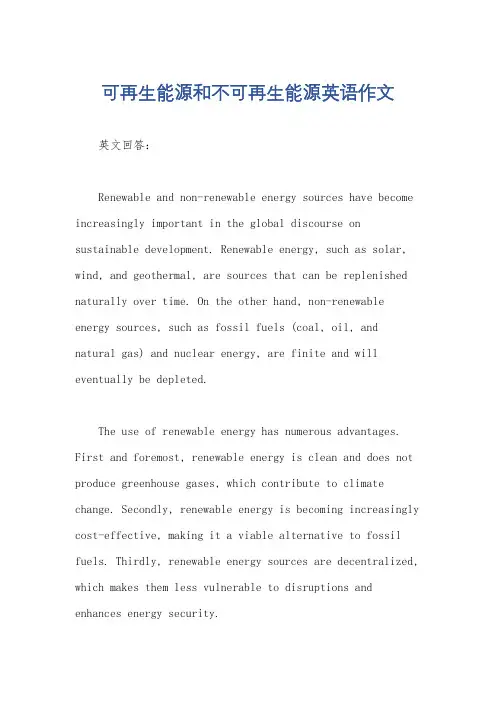
可再生能源和不可再生能源英语作文英文回答:Renewable and non-renewable energy sources have become increasingly important in the global discourse on sustainable development. Renewable energy, such as solar, wind, and geothermal, are sources that can be replenished naturally over time. On the other hand, non-renewable energy sources, such as fossil fuels (coal, oil, and natural gas) and nuclear energy, are finite and will eventually be depleted.The use of renewable energy has numerous advantages. First and foremost, renewable energy is clean and does not produce greenhouse gases, which contribute to climate change. Secondly, renewable energy is becoming increasingly cost-effective, making it a viable alternative to fossil fuels. Thirdly, renewable energy sources are decentralized, which makes them less vulnerable to disruptions and enhances energy security.However, renewable energy also has some limitations. One major challenge is intermittency. Solar and wind energy are not always available, and they can fluctuate significantly depending on weather conditions. This intermittency makes it difficult to rely solely on renewable energy sources to meet baseload demand. Secondly, the development of renewable energy projects often requires large upfront investments, which can be a barrier to entry for some communities.Non-renewable energy sources, on the other hand, are reliable and have high energy density. They have been the backbone of the global energy system for decades. However, the use of non-renewable energy sources comes with significant environmental and health risks. The combustion of fossil fuels releases harmful pollutants into the air, contributing to air pollution and respiratory illnesses. Additionally, the extraction and transportation of fossil fuels can have devastating impacts on ecosystems and biodiversity.Moreover, non-renewable energy sources are finite and will eventually run out. The world's reserves of fossil fuels are rapidly depleting, and it is estimated that we have only a few decades of oil and gas left. This scarcity creates a sense of urgency to transition to renewable energy sources.In conclusion, both renewable and non-renewable energy sources have their own advantages and disadvantages. Renewable energy is clean, sustainable, and becoming increasingly cost-effective. However, it is intermittent and requires large upfront investments. Non-renewable energy sources are reliable and have high energy density, but they are polluting, finite, and contribute to climate change. As the world faces the challenges of climate change and energy security, it is imperative to transition to a more sustainable energy system that relies primarily on renewable energy sources.中文回答:可再生能源和不可再生能源。
环保术语的英汉翻译发布人:圣才学习网发布日期:2010-08-20 16:53 共17人浏览[大] [中] [小] [摘要] 目前,国际社会对环境保护问题的重视程度不断提高,我国也是如此。
在同国际接轨的过程中,我们必然涉及对大量环保词汇的引进及其翻译问题。
为此,笔者查找了大量资料,将各领域的主要环保词汇及其现有中文译名进行了归纳和整理,希望能对今后的相关翻译工作有所帮助。
[关键词] 环保术语中文译名1 概述随着当今世界经济的迅猛发展和全球经济一体化进程的不断推进,可持续发展问题已同和平问题并列为世界两大主题,备受关注。
而环境保护问题,作为可持续发展中很重要的一项,正渗透到人们社会生活中的各个方面,成为不单是环保工作者而且是全人类共同关注的大事。
我国在这一领域起步相对较晚,有许多须借鉴西方之处。
正是这一过程,涉及到大量环保词汇的引进和翻译一事。
如果没有准确、易解的译名,我们的环保事业和日常宣传将面临许多麻烦和误区。
目前,国内相关的词典和文章较少且零散,给翻译工作带来种种不便。
为此,笔者寻找了大量资料,整理出部分较集中并已经认可的环保术语及其中文译名,在此加以归类,希望能对今后的相关翻译工作有所帮助。
以下,笔者将从环境科学、工农业生产环保、日常生活环保和环保法律法规等方面对其分别进行介绍。
2 环境科学方面环境科学是一门精密而广博的学科。
由于环境保护这一课题的特殊性,它对大千世界的各类物质从环保的角度出发进行了严格定义,主要分有:returnable or recyclable(可回收利用的),disposable(一次性的或不可回收利用的),explosive(爆炸性的),reactive(易起化学反应的)等。
在能源方面,又分为renewable or nonrenewable energy sources (可再生和不可再生能源),non-polluting or polluting energy sources(无污染和污染性能源)。
IPCC:the Intergovernmental Panel on Climate Change 政府间气候变化小组: three Working Groups reports: 三个工作小组报告Synthesis report 综合报告Glaciers 冰川Precipitation 降雨Abnormal weathertropical, subtropical and Mediterranean regions 热带、亚热带和地中海地区cyclones 气旋,龙卷风meteorological terms 气象词汇submergence 淹没coral reefs 珊瑚礁, tundra 永冻土,boreal forest 北部森林inertia 惯性mitigation 减缓the Arctic region 北极地区the Antarctic region 南极地区ice cap 冰帽 ice sheet 冰原mass-balance of glacier 冰川的物料平衡/量ripple effect 波纹效应chain effect 连锁反应low-carbon economy 低碳经济assessment 评估vulnerable areasconcentration, carbon dioxide 二氧化碳浓度 ppmcarbon dioxide equivalent 二氧化碳当量North Hemisphere 北半球water scarcity, food security, epidemic 缺水、缺食、流行病scenario 情况,情景social check & balance 社会制约与平衡legislation , jurisdiction and executive 立法、司法和行政mega-delta 大三角地区,巨型三角洲地区adapt to, adaptationfrequency and severity 频率和严重性polar areas 北极地区on the verge of extinction 灭绝Immune: 免疫Reduction of emissions 减排Interim target 中期目标Renewable energy: 可再生能源Geothermal:地热能Ratify 批准KP Kyoto Protocol 京都议定书Carbon emissions and Efficiency benchmark:碳排放能效对标Deforestation:滥砍滥伐Clean coal technology 清洁煤炭技术National capacity 国力Rigorous 严格的Common but differentiated responsibility:共同但有差别的责任Coal-fired Power Plants ( station) 火力发电厂Bring that ….to fruition 取得成效Inaction:不作为Mandatory cap: 强制性的Forest cover 森林覆盖率Interconnected Carbon marketDeploy low-emission technology 利用低排放技术Verifiable 可认证的Ministerial-level 部长级The Sign is clear 这一点很清楚media friends 媒体的朋友:glossy paper 铜版纸call upon 号召water conservation benefits节水的好处industrial water reuse and recycling工业中水利用pollution fines 污染罚款urban water conservation城市节水water saving fixtures节水装置regional economy 地区经济diversification in port operation 港口经营多元化perform our duties and fulfill our obligations 责任和义务a well-known regional event of the industry 地区行业盛会initiating ports 发起港forest coverage森林覆盖率global warming全球变暖principal element主要因素toxic emission 废气排放ignite the sparks of understanding 迸发出心灵的火花建立合作桥梁build the bridge for cooperation内容翔实substantial in content能源大省major province of energy日程紧凑tight in schedule严重缺水城市a city of severe water shortage有关单位units concerned与…比有差距compared with ,there is still some way to go预祝…圆满成功wish a complete success开源与节流并重broaden sources of income &reduce expenditure 对外贸易港口seaport for foreign trade国内生产总值National Gross Products欢聚一堂merrily gather活跃的经济带vigorous economic region基础雄厚solid foundation留下最美好的印象may you have a most pleasant impression盛世the grand occasion祝愿在停留愉快wish a pleasant stay综合性商港comprehensive commercial seaport春意盎然spring is very much in the air把…列为重要内容place as the priority不放松工作never neglect the work节约用水 water conservation对…表示衷心祝贺extend our sincere congratulations on节约用水先进城市model city of water conservation使…取得预期效果attain the results expected授予…光荣称号 confer honorable awards on为…而奋斗strive for从大局出发proceed from the whole situation财政政策financial policy共同繁荣common prosperity贸易投资自由化trade and investment liberalization日新月异progress with each passing day知识经济knowledge economy环保:Environmental protection1. 保护和改善生活和生态环境 protect and improve the living environment and the ecological environment2. 保护珍贵动植物 protect rare animals and plants3. 普及环保知识 popularize environmental protection knowledge4. 增强环境意识enhance the awareness of the importance of (raise the consciousness about) environmental protection5. 改善生态环境 improve the eco-environment6. 加强生态建设 improve the eco-construction7. 防治污染 prevent and control pollution8. 加强水土保持 reinforce the conservation of water and soil9. 加强城市绿化 strengthen the greening of the city10. 提高环境管理水平 raise the environmental management level11. 享受国家一级保护 enjoy first-class protection of the State12. 加强环境保护 strengthen environmental protection13. 保持生态平衡 keep ecological balance14. 创造良好的生态环境 create a pleasant ecological environment15. 采用环保技术 adopt environmental protection technique16. 开展保护野生动物 advocate to educate the public the protection of wild animals17. 开展绿色活动 advocate green activities18. 为大量野生动植物提供栖息地 provide habitats for a huge number of wild animals and plants19. 为人类提供水和食物 supply water and food for human beings20. 非常注重保护森林 pay great attention to the conservation of forest21. 产生巨大的水文效应 produce great hydrological effects22. 引发一系列的问题 result in a series of problems23. 帮助减缓全球变暖速度 help slow down the pace of global warming24. 保留为自然耕地 reserve as natural farmland25. 提高居民的环保和生态意识improve residents’ environmental and ecological awareness26. 进一步加快环保规划 further speed up environmental protection plans27. 完善城市基础设施建设 perfect the construction of urban infrastructure28. 促进城市可持续发展 promote the sustainable development of the city29. 符合举办奥运会的要求 meet the requirements of hosting the Olympic Games30. 扩建管道网络 expand the pipe network31. 淘汰或改造燃煤锅炉 eliminate or convert coal-burning boilers32. 禁止露天焚烧 prohibit burning out in the open33. 发展太阳能 develop solar energy34. 提高清洁能源的比重 increase the supply of clean energy resources35. 减少机动车辆 reduce the number of vehicles36. 使用清洁能源 burn clean fuel37. 实行严格的机动车排放标准 implement strict vehicle emission standards38. 关闭化工厂 close chemical plants39. 减少浪费 reduce waste40. 加大污染治理力度 strengthen pollution control41. 治理沙地和水土流失问题 tackle the problems of sand and soil erosion42. 加强珍稀野生动植物的保护工作 protect rare wild animals and plants43. 崇尚绿色生活方式 pursue a “green” life44. 使用再生纸 use recycle paper45. 参加环保运动 take part in environmental protection activities46. 坚持门前三包制度 adhere to “the three responsibilities in the gate area’47. 参加城市重建 participate in the reconstruction of the city48. 注重节约资源 attach importance to saving resources49. 采用新的开采方法 apply new exploitation methods50. 削减污物排放 decrease the disposal of pollutantsbiodegradable packaging 可降解包装throwaway 可丢弃的disposable 可丢弃的discourage v. 不鼓励燃料的环保英语词汇:non-renewable 不可再生的fossil fuels矿石燃料: natural gas, coal, petroleumlimited/finite natural resources 有限的自然资源alternative energy替代能源replace=substitute v.取代(wind power, hydropower水电solar (lunar) power太阳能nuclear power核能radioactivity n. 辐射性use up, deplete, exhaust v. 用光,耗尽conserve v. 节省,节约consume less v. 少消耗危害动物的环保英语词汇:poaching非法打猎,盗猎damage natural habitat 破坏自然栖息地rare breed稀有物种endangered species濒危物种extinct adj.灭绝 (die out, disappear动词)animal rights activist动物权益保护者natural reserve(giant panda大熊猫)自然保护区protect wild life保护野生动物disastrous灾难性的, devastation破坏have disastrous effect on…对……有灾难性的影响危害植物的环保英语词汇:vegetation植被deforestation森林消失landslide山体滑坡危害环境的环保英语词汇:carbon dioxide二氧化碳acid rain酸雨(erode腐蚀)greenhouse effect温室效应 (worsening, deteriorate, deterioration恶化)global warming全球变暖ecological system=ecosystem生态系统green belt绿化带, sand storm沙尘暴, (filter v. 过滤)arouse people's awareness/consciousness of environmental protection提高公众的环保意识全球环保类热门话题英语词汇:21世纪议程:Agenda 21世界环境日(6月5日):World Environment Day (June 5th each year)世界环境日主题:World Environment Day Themes冰川消融,后果堪忧!(2007年)Melting Ice–a Hot Topic!莫使旱地变荒漠!(2006年)Deserts and Desertification–Don't Desert Drylands! 营造绿色城市,呵护地球家园!(2005年)Green Cities – Plan for the Planet!海洋存亡,匹夫有责!(2004年)Wanted! Seas and Oceans – Dead or Alive!水——二十亿人生命之所系!(2003年)Water - Two Billion People are Dying for It! 让地球充满生机!(2002年)Give Earth a Chance!世间万物生命之网!(2001年)Connect with the World Wide Web of life!环境千年-行动起来吧!(2000年)The Environment Millennium - Time to Act!拯救地球就是拯救未来!(1999年)Our Earth - Our Future - Just Save It!为了地球上的生命-拯救我们的海洋!(1998年) For Life on Earth - Save Our Seas!为了地球上的生命!(1997)For Life on Earth我们的地球、居住地、家园:(1996)Our Earth, Our Habitat, Our Home国际生物多样性日(12月29日):International Biodiversity Day (29 December)世界水日(3月22日):World Water Day (22 March)世界气象日(3月23日):World Meteorological Day (23 March)世界海洋日(6月8日):World Oceans Day (8 June)植树节(3月12日):Arbor Day (12 March)面临的环境保护问题及污染问题英文词汇:废水:waste/polluted water废气:waste/polluted gas废渣:residue工业固体废物:industrial solid wastes白色污染:white pollution (by using and littering of non-degradable white plastics)有机污染物:organic pollutants森林砍伐率:rate of deforestation水土流失:water and soil erosion土壤盐碱化:soil alkalization濒危野生动物:endangered wildlife环境恶化:environmental degradation城市化失控:uncontrolled urbanization温室效应:greenhouse effect全球变暖:global warming环保问题拯救措施及污染治理相关英语口译词汇:中国环保基本政策:the basic policies of China's environmental protection预防为主、防治结合的政策:policy of of prevention in the first place and integrating prevention with control治理环境污染:curb environmental pollution; bring the pollution under control 可降解一次性塑料袋:throwaway bio-degradable plastics bags垃圾填埋场:refuse landfill垃圾焚化场:refuse incinerator防止过度利用森林:protest forests from overexploitation水土保持:conservation of water and soil水资源保护区:water resource conservation zone造林工程:afforestation project珍稀濒危物种繁育基地:rare and endangered species breeding center 绿化祖国:turn the country green全民义务植树日:National Tree-Planting Day森林覆盖率:forest coverage防风林:wind breaks防沙林:sand breaks速生林:fast-growing trees降低资源消耗率:slow down the rate of resource degradation开发可再生资源:develop renewable resources环保产品:environment-friendly products自然保护区:nature reserve“低碳”词汇低碳 Low-Carbon低碳经济 Low-Carbon Economy(LCE)低碳生活 Low-Carbon Life低碳旅游 Low-Carbon Tour低碳城市化道路Low-Carbon urbanization way碳 Carbon二氧化碳 Carbon dioxide二氧化碳排放 the output of the carbon dioxide二氧化碳浓度Atmospheric concentrations of carbon dioxide碳减排Carbon emission reduction碳排放标准 Standard for carbon dioxide emission碳排放责任 Liability for carbon dioxide emission越境碳污染 Trans-frontier carbon dioxide pollution一氧化碳 Carbon monoxide温室气体 Greenhouse gas(GHS)温室气体排放 Greenhouse gas emission温室效应 Greenhouse effect全球气候变暖 Global warming生物圈 Biosphere大气层 Atmosphere大气模型 Atmospheric models空气质量管理 Air quality management大气监测 Atmospheric monitoring大气修正 Atmospheric corrections大气层的化学成分Chemical composition of the atmosphere臭氧层 Ozone layer紫外线 Ultraviolet ray红外线 Infrared环境 Environment生态 Ecology生态系统 Ecosystem工业烟尘 Industrial fumes环境核算 Environmental accounting环境审计 Environmental auditing环境健康影响评价 Environmental health impact assessment 环境影响 Environmental impact环境影响评价 Environmental impact assessment环境影响状报告书 Environmental impact statement环境指标 Environmental indicators环境政策 Environmental policy环境风险评估 Environmental risk assessment可持续发展 Sustainable developmentPollution:环境污染相关英语词汇集锦污染物aerosols 气溶胶 / 气雾剂agricultural wastes 农业废物asbestos 石棉commercial noise 商业噪音composite pollution 混合污染dioxins 二恶英hazardous substances 危险物质hazardous wastes 危险废物heavy metals 重金属hospital wastes 医院废物industrial effluents 工业废水industrial emissions 工业排放物industrial fumes 工业烟尘industrial noise 工业噪声inorganic pollutants 无机污染物lead contamination 铅污染liquid wastes 液体废物litter 丢弃物 / 废气物mercury contamination 汞污染micropollutants 微污染物mining wastes 采矿废物motor vehicle emissions 机动车辆排放物municipal waste 城市废物nitrogen oxides 氮氧化物noise pollution 噪声污染odour nuisance 恶臭公害organic pollutants 有机物污染persistent organic pollutants 难降解有机污染物pharmaceutical wastes 医药废物plastic wastes 塑料废物radioactive substances 放射性物质rubber waste 橡胶废物sewage 污水solid wastes 固体废物thermal pollution 热污染toxic substances 有毒物质toxic waste 有毒废物toxins 毒素traffic noise 交通噪音trash 废物 / 垃圾wood waste 木材废料污染源biological weapons 生物武器cement industry 水泥工业chemical weapons 化学武器chimneys 烟囱motor vehicles 机动车辆motorcycles 摩托车nuclear weapons 核武器ocean dumping 海洋倾倒oil spills 石油泄漏scrap metals 废金属excavation heaps 挖掘堆积污染治理acoustic insulation 隔音chemical decontamination 化学污染清除desulphurization of fuels 燃料脱硫filters 过滤器noise abatement 噪音治理pollution abatement equipment 污染治理设备pollution control technology 污染控制技术radiation protection 辐射防护scrubbers 洗涤器separators 分离器smoke prevention 防烟waste minimization 废物最少化废物battery disposal 电池处理chemical treatment of waste 废物的化学处理disposal sites 处置场所incineration of waste 废物焚烧mine filling 矿山回填oil residue recuperation 残油回收radioactive waste management 放射性废物管理recycled materials 回收的材料recycling 回收reuse of materials 材料再利用sanitary landfills 卫生填埋sea outfall 海洋排泄口septic tanks 化粪池sewage disposal 污水处置sewage treatment systems 污水处理系统solid waste disposal 固体废物处置waste assimilation capacities 废物同化处置waste conversion techniques 废物转化技术waste disposal 废物处置waste disposal in the ground 废物土地处置waste recovery 废物回收waste use 废物利用water reuse 水的再利用环境保护词汇集锦与环境保护有关的词汇World Environment Day Themes 历年世界环境日主题2006世界环境日主题:“沙漠和荒漠化--莫使旱地变荒漠”2006 Deserts and Desertification-Don't Desert Drylands!中国主题:生态安全与环境友好型社会1974 Only one Earth 只有一个地球1975 Human Settlements人类居住1976 Water: Vital Resource for Life 水:生命的重要源泉1977 Ozone Layer Environmental Concern; Lands Loss and Soil Degradation; Firewood 关注臭氧层破坏,水土流失1978 Development Without Destruction没有破坏的发展1979 Only One Future for Our Children - Development Without Destruction为了儿童和未来--没有破坏的发展1980 A New Challenge for the New Decade: Development Without Destruction新的十年,新的挑战--没有破坏的发展1981 Ground Water; Toxic Chemicals in Human Food Chains and Environmental Economics保护地下水和人类的食物链,防治有毒化学品污染1982 Ten Years After Stockholm (Renewal of Environmental Concerns)斯德哥尔摩人类环境会议十周年--提高环境意识1983 Managing and Disposing Hazardous Waste: Acid Rain and Energy管理和处置有害废弃物,防治酸雨破坏和提高能源利用率1984 Desertification沙漠化1985 Youth: Population and the Environment青年、人口、环境1986 A Tree for Peace 环境与和平1987 Environment and Shelter: More Than A Roof 环境与居住1988 When People Put the Environment First, Development Will Last保护环境、持续发展、公众参与1989 Global Warming; Global Warning警惕全球变暖1990 Children and the Environment儿童与环境1991 Climate Change. Need for Global Partnership气候变化--需要全球合作1992 Only One Earth, Care and Share只有一个地球--一齐关心,共同分享1993 Poverty and the Environment - Breaking the Vicious Circle贫穷与环境--摆脱恶性循环1994 One Earth One Family 一个地球,一个家庭1995 We the Peoples: United for the Global Environment各国人民联合起来,创造更加美好的未来1996 Our Earth, Our Habitat, Our Home 我们的地球、居住地、家园1997 For Life on Earth 为了地球上的生命1998 For Life on Earth - Save Our Seas 为了地球上的生命--拯救我们的海洋1999 Our Earth - Our Future - Just Save It! 拯救地球就是拯救未来2000 2000 The Environment Millennium - Time to Act2000环境千年 - 行动起来吧!2001 Connect with the World Wide Web of life世间万物生命之网2002 Give Earth a Chance 让地球充满生机2003 Water - Two Billion People are Dying for It! 水--二十亿人生命之所系2004 Wanted! Seas and Oceans - Dead or Alive? 海洋存亡匹夫有责2005 Green Cities - Plan for the Planet! 营造绿色城市,呵护地球家园中国主题:人人参与创建绿色家园联合国环境与发展大会(环发大会) United Nations Conference on Environment and Development (UNCED)环发大会首脑会议 Summit Session of UNCED联合国环境规划署 United Nations Environment Programs (UNEP)国际生物多样性日 International Biodiversity Day (29 December)世界水日 World Water Day (22 March)世界气象日 World Meteorological Day(23 March)世界海洋日 World Oceans Day (8 June )人与生物圈方案 Man and Biosphere (MAB) Programme (UNESCO)中国21世纪议程 China's Agenda 21中国生物多样性保护行动计划 China Biological Diversity Protection Action Plan中国跨世纪绿色工程规划 China Trans-Century Green Project Plan生物多样性公约 Convention on Biological Diversity防治荒漠化国际公约 Convention to Combat Desertification气候变化框架公约 United Nations Framework Convention on Climate Change国家环境保护总局 State Environmental Protection Administration (SEPA)坚持环境保护基本国策 adhere to the basic state policy of environmental protection 污染者负担的政策 "the-polluters-pay" policy强化环境管理的政策 policy of tightening up environmental management环保执法检查 environmental protection law enforcement inspection限期治理 undertake treatment within a prescribed limit of time生态示范区 eco-demonstration region; environment-friendly region国家级生态示范区(珠海) Nationally Designated Eco-Demonstration Region国家级园林城市 Nationally Designated Garden City工业固体废物 industrial solid wastes白色污染 white pollution (by using and littering of non-degradable white plastics) 可降解一次性塑料袋 throwaway bio-degradable plastic bags放射性废料积存 accumulation of radioactive waste有机污染物 organic pollutants三废综合利用 multipurpose use of three types of wastes(waste water, waste gas, solid waste)城市垃圾无害化处理率 decontamination rate of urban refuse垃圾填埋场 refuse landfill垃圾焚化厂 refuse incinerator防止过度利用森林 protect forests from overexploitation森林砍伐率 deforestation rate水土流失 water and soil erosion土壤盐碱化 soil alkalization生态农业 environment-friendly agriculture; eco-agriculture水资源保护区 water resource conservation zone海水淡化 sea water desalinization造林工程 afforestation project绿化面积 afforested areas; greening space森林覆盖率 forest coverage防风林 wind breaks防沙林 sand breaks速生林 fast-growing trees降低资源消耗率 slow down the rate of resource degradation开发可再生资源 develop renewable resources环保产品 environment-friendly products自然保护区 nature reserve野生动植物 wild fauna and flora保护生存环境 conserve natural habitats濒危野生动物 endangered wildlife珍稀濒危物种繁育基地 rare and endangered species breeding center美化环境 landscaping design for environmental purposes环境恶化 environmental degradation温饱型农业 subsistence agriculture空气污染浓度 air pollution concentration酸雨、越境空气污染 acid rain and transboundary air pollution工业粉尘排放 industrial dust discharge烟尘排放 soot emissions矿物燃料(煤、石油、天然气) fossil fuels: coal, oil, and natural gas 清洁能源 clean energy汽车尾气排放 motor vehicle exhaust尾气净化器 exhaust purifier无铅汽油 lead-free gasoline天然气汽车 gas-fueled vehicles电动汽车 cell-driven vehicles; battery cars小排量汽车 small-displacement (engine) vehicles温室效应 greenhouse effect工业废水处理率 treatment rate of industrial effluents城市污水处理率 treatment rate of domestic sewage集中处理厂 centralized treatment plant。
2009年环保热词一网打尽(附哥本哈根气候大会专有名词)碳税 carbon tax联合国气候变化会议于当地时间12月7日在哥本哈根召开。
中国是否有必要实施碳税?又该如何减少碳税实施后对公众福利的影响?对此,专家指出,只有进一步节能减排,才能逾越西方发达国家今后可能设立的贸易壁垒。
温室气体排放税(费)或者碳税(费)政策可以起到宏观调控的作用。
请看《中国日报》的报道:Carbon tax, one of the market mechanisms that China is considering adopting, will raise the current energy price from fossil fuel sources, including gasoline, electricity, coal and natural gas.“碳税”是中国正在考虑要实行的市场机制之一,该机制的实行将提高现有包括汽油、电力、煤炭和天然气等在内的化石能源的价格。
文中的carbon tax就是指“碳税”,是基于市场的主要减排方案之一,根据fossil fuel(化石燃料)燃烧后排放碳量的多少,针对化石燃料的生产、分配或使用来征收税费。
而相比之下,使用wind(风力),sunlight(日光),hydropower(水电)等non-combustion energy sources(非燃烧能源)则更加环保。
Carbon tax是一种针对greenhouse gas(温室气体)中的emissions of carbon dioxide(二氧化碳排放)征收的environmental tax(环境税)。
征收carbon tax 的目的在于控制climate change(气候变化)和global warming(全球变暖)。
此外,人们还常采用carbon capture and storage(碳捕获和存储)等方法来处理emissions of carbon dioxide。
可再生能源和不可再生能源雅思作文
At present, oil and coal are the main energy sources, but they are limited non-renewable energy sources and will be used up one day. And encouraging these may lead to a series of environmental problems. However, nuclear energy is a new and inexhaustible new energy. It is a renewable energy, harmless to the environment and has a broad development prospect. Although due to the limitation of human technology, we can't find some nuclear waste. But I believe that one day nuclear energy will replace ordinary energy such as oil and become an important energy source.
翻译:
现在石油和煤炭是主要能源,但它们是有限的不可再生能源,总有一天会用完。
而助长这些可能会导致一系列的环境问题。
然而核能是一种新的、取之不尽的新能源,它是可再生能源,它对环境无害,具有广阔的发展前景。
虽然由于人类技术的限制,我们无法找出一些核废料。
但是我相信有一天核能会取代石油等普通能源,成为一种重要的能源。
绿色低碳领域涉及到许多专业术语,这些术语通常用于描述可持续发展、环保和低碳经济等概念。
以下是一些相关的英文术语:1. **Green Technology (绿色技术):** 技术和创新,旨在减少对环境的负面影响,并促进可持续发展。
2. **Renewable Energy (可再生能源):** 指那些可以在自然过程中不断补充的能源,如太阳能、风能、水能等。
3. **Energy Efficiency (能源效率):** 在提供一定服务或产出的情况下,最小化能源消耗的能力。
4. **Carbon Footprint (碳足迹):** 个人、组织或产品在生命周期内产生的温室气体排放总量。
5. **Sustainable Development (可持续发展):** 满足当前需求,而不妨碍后代满足其需求的发展方式。
6. **Eco-friendly (环保的):** 对环境无害或对环境造成最小负担的特性。
7. **Low Carbon Economy (低碳经济):** 通过减少温室气体排放,实现经济增长和发展的经济体系。
8. **Circular Economy (循环经济):** 一种优化资源利用的经济模式,通过循环再利用和回收减少废弃物。
9. **Carbon Neutral (碳中和):** 在一定时间内抵消碳排放,使净碳排放为零。
10. **Sustainability Reporting (可持续性报告):** 公司或组织向利益相关方报告其社会、环境和经济方面的可持续性绩效。
11. **Green Building (绿色建筑):** 采用环保设计和建造原则,最小化对环境的影响的建筑。
12. **Carbon Capture and Storage (碳捕获与储存):** 一种技术,用于捕获工业排放的二氧化碳并将其安全地储存在地下。
这些术语反映了在绿色低碳领域中关注的关键概念和原则。